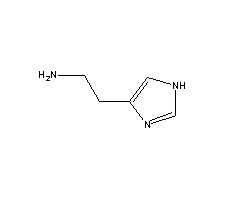C O N T E N T SSee AlsoDescription
Histamine is an important protein involved in many allergic reactions. Allergies are caused by an immune response to a normally innocuous substance (i.e. pollen, dust) that comes in contact with lymphocytes specific for that substance, or antigen. In many cases, the lymphocyte triggered to respond is a mast cell. For this response to occur, a free-floating IgE (an immunoglobulin associated with allergic response) molecule specific to the antigen must first be attached to cell surface receptors on mast cells. Antigen binding to the mast cell-attached IgE then triggers the mast cell to respond. This response often includes the release of histamine DiscussionThe release of histamine (hist = because it's made up of histidine residues, amine = because it's a vasoactive amine) causes several allergic symptoms. Histamine can cause inflammation directly as well as indirectly. Upon release of histamine by an antigen activated mast cell, permeability of vessels near the site is increased. Thus, blood fluids (including leukocytes, which participate in immune responses) enter the area causing swelling. This is accomplished due to histamine's ability to induce phosphorylation of an intercellular adhesion protein (called (VE)-cadherins) found on vascular endothelial cells. That is why histamine is known as being vasoactive. Gaps between the cells in vascular tissue are created by this phosphorylation, allowing blood fluids to seep out into extracellular space. Links |

